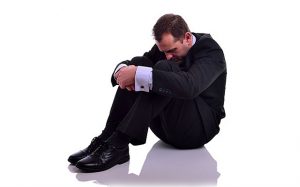Young British Gay & Bi Men Six Times More Likely to Attempt Suicide
Young British Gay & Bi Men Six Times More Likely to Attempt Suicide
A new U.K. study found that the risk of suicide attempts is six times higher among gay and bisexual men under the age of 45—and that rates are even higher for those of colour.
Young gay and bisexual men in the United Kingdom are six times more likely to attempt suicide than their counterparts over the age of 45.
That shocking number only goes up for those who are black, poor, or less educated, researchers at the London School of Hygiene & Tropical Medicine (LSHTM) found. The team used nearly 6,000 responses to the Stonewall Gay and Bisexual Men’s Health Survey (PDF) to analyse how age, ethnicity, income, and other factors affected depression, anxiety, and suicidality.
Their findings, now published in the Journal of Public Health, show how additional stressors can compound an already alarming risk of suicide in the LGBT community.
“Minority groups are usually thought to be more homogeneous then they actually are, when, in fact, there is great variation in health and life situations among this group,” Dr. Ford Hickson, a public health professor at LSHTM and lead author of the study, said in a press release.
“What’s clear is that health inequalities among gay and bisexual men mirror those in the broader society.”
Age and racial differences were among the most dramatic variations in their sample. Nearly 6 percent of gay and bisexual men ages 26 and under reported a suicide attempt in the last year as compared to just 1 percent of those 45 or over.
Black gay and bisexual men were also found to be five times more likely to have attempted suicide than their white peers and twice as likely to suffer from depression.
“This is possibly because men are better able to cope with homophobia the older they are, or if they are relatively privileged in other areas of their lives,” Dr. Hickson said.
In addition to hypothesizing that older men may have developed better tools for dealing with prejudice, the authors note that the age gap in suicide risk is “congruent with homophobic abuse and assault being very disproportionately experienced by the young.” Younger LGBT people must endure bullying in schools, for example, while older people generally do not.
As the study notes, broad disparities in suicide risk between the LGBT population and the general population are generally explained in terms of the Meyer minority stress model, which posits a relationship between experiences of social marginalization and poor health outcomes.
But this broader theory can sometimes be applied in a way that glosses over the many demographic differences within larger gender and sexual minorities. By analyzing the impact of individual social factors, the authors of the LSHTM study were able to show that gay and bisexual men’s mental health is not a monolith.
For instance, bisexual men generally had worse mental health outcomes than their gay peers, likely as a result of the specific stigma around people who are attracted to more than one gender. And nearly 30 percent of gay and bi men who left school at age 16 reported suffering from depression, while only 17 percent of those who had university education reported the same.
Some differences were subtle but still significant. For example, Asian gay and bisexual men were more likely to suffer from depression than their white counterparts but less likely to have self-harmed or attempted suicide.
“Poor mental health is not evenly distributed across race, income, or education,” said Dr. Hickson of the study’s implications. “We must ensure that access to life-changing support services are targeted to where they are needed most.”
In the meantime, Dr. Hickson’s study does offer hope for one subset of gay and bisexual men: those who live with boyfriends or husbands.
“Living with a male partner was associated with half the odds of depression, three-quarters the odds of anxiety, a third the odds of suicide attempt, and two-fifths the odds of self-harm relative to men living alone,” the study found. “Living with someone other than a male partner was not associated with protective effects.”
Source: The Daily Beast
If you need support
Grassroots Suicide Prevention:
Supporting communities to prevent suicide, one life at a time. We teach suicide alertness and intervention skills to community members and professionals. Together we can make our communities safer from suicide.
Based in the South East of England, since 2006 we have trained over 5,000 people in suicide prevention and mental health both locally and nationally. We have seats on several advisory committees in Brighton & Hove and have contributed to both local and national suicide prevention and self-harm strategies.
We are proudly working towards making Brighton & Hove the UK’s first Suicide-Safer City
www.prevent-suicide.org.uk/index.html
Source: Grassroots Suicide Prevention




